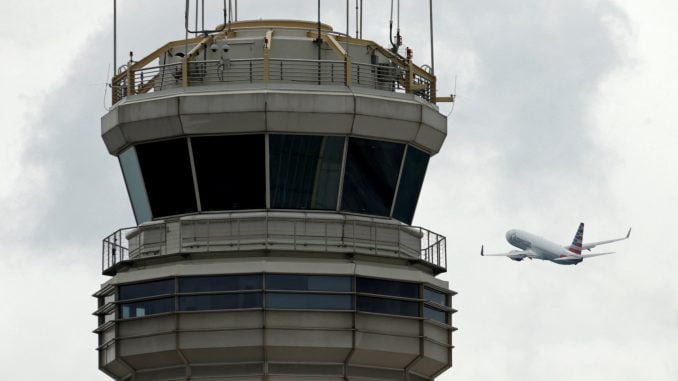
SEATTLE – Inside the control tower at John F. Kennedy International Airport, air traffic controllers can track planes traveling hundreds of miles away.But when it’s time for a controller to hand off responsibility for watching a flight, the technology becomes decidedly last century: details are printed on a slip of paper and passed to a co-worker.President Donald Trump promised on Monday to sweep away such outmoded systems and replace them with “the best, newest and safest technology available.”Trump’s solution is to split air traffic control away from the Federal Aviation Administration and privatize it under a not-for-profit, independent corporation.Billions of dollars in government and private contracts ride on the conversion of the nation’s air traffic control system to satellite-based GPS. A federal modernization program known as NextGen has already targeted traditional ground-based radar and other aging technologies for replacement.Still, the United States lags well behind other countries including Canada, Ireland and Denmark, whose satellite-based GPS systems are slated to go live next year.Private-sector companies angling for a piece of this business see wide commercial potential for products unleashed by the U.S. modernization effort, including digital cockpit messaging, live monitoring of aircraft engines and systems, advanced weather maps and faster internet service for passengers.”It’s a big deal for us,” said David Nieuwsma, a senior vice president in charge of such systems at Rockwell Collins Inc . “We know it’s the future.”DELAY AND EXPENSECongress gave the FAA $7.4 billion between 2004 and 2016 to develop and install NextGen systems. The aim was to boost the capacity of the U.S. aviation system to handle more planes, cut flight delays and improve safety, according to a Government Accountability Office report published in November.Airlines support NextGen and are expected to spend $15 billion upgrading their fleets to prepare for the new systems. But industry players have grown frustrated as the FAA missed implementation deadlines.The agency now estimates NextGen will cost another $14.8 billion to complete, with many major upgrades not due to be functional until 2025, the GAO said. Proponents say privatization will speed NextGen by freeing it from FAA bureaucracy. Modeled after Canada’s widely praised 1996 privatization, which created an entity known as Nav Canada, the U.S. plan has the backing of most U.S. airlines as well as qualified support from the air traffic controllers union.Critics, including Delta Air Lines, the National Business Aviation Association and an organization of FAA safety inspectors and technicians, say Congress should instead enact a law to stabilize FAA’s NextGen funding, which is controlled by Congress.”Privatizing the largest and most complex aviation system in the world is a risky and unnecessary step at this pivotal point in its modernization,” said Mike Perrone, head of the Professional Aviation Safety Specialists, a union of 11,000 FAA safety employees, after Trump’s announcement. “This would slow down enhancements and possibly compromise safety to fix a system that’s not broken.”BOUNCING OFF THE SATELLITESCentral to the modernization effort are global positioning satellites that can track planes more accurately than radar, enabling controllers to reduce the distance between aircraft during flight. That allows more takeoffs and landings, which is essential to meet rising global demand for air travel.That’s creating opportunities for a host of U.S. firms.McLean, Virginia-based Iridium Communications owns a network of satellites for voice and data transmission. Through a joint venture known as Aireon, it has partnered with Nav Canada and several other air traffic control organizations to roll out a global satellite air navigation system planned to go into operation next year.Aireon recently began tests with the FAA on eight satellites Iridium launched in January. The consortium is among the top contenders for a multibillion-dollar contract that the agency is expected to award next year.Aireon already has contracts with 30 air navigation service providers. But FAA approval is “the gold standard” that likely would prompt more countries to sign up, Iridium Chief Executive Matt Desch said in an interview.Meanwhile, the increasing sophistication of commercial and private jets means more opportunities for aerospace manufacturers such as Honeywell International.Headquartered in Morris Plains, New Jersey, Honeywell recently introduced a weather application that uses “crowdsourced” data from other planes in flight to give pilots a real-time map of turbulence and storms.”Those things didn’t exist before. We’re inventing them,” said Carl Esposito, president of the Honeywell business that provides cockpit, navigation, space and safety systems.Systems by Honeywell and others, such as Chicago-based Gogo Inc, are using satellites to give planes internet service fast enough for passengers to stream Netflix and similar services. Pilots can use the same pipeline to share data with each other and ground control.Rockwell Collins, based in Cedar Rapids, Iowa, is working with Hawaiian Airlines and the FAA to certify the safety of a satellite system for aircraft status messages. The messages, known as ACARS, have been in use for decades. The satellite system would extend that reach.CONTROLLER JOBS DECLININGBut pressure to modernize has not resolved the debate about the FAA’s structure. Trump’s spin-off plan mirrors one advocated by U.S. Rep. Bill Shuster, the Pennsylvania Republican who chairs the House Transportation Committee.Critics say shifting some 14,000 controllers and other FAA employees to a new corporation could potentially compromise safety, hand airlines too much power and put technology upgrades even further behind schedule.Proponents say a private entity could tap capital markets and sign contracts quickly by avoiding the FAA’s slow procurement process. It also gets workers off the federal payroll.Modernization could reduce the number of unionized controllers, who earn $130,000 to $180,000 a year according to online listings.The National Air Traffic Controllers Association, which represents the workers, says it supports a non-profit corporation as long as it preserves safety, provides stable funding and protects its workforce while ensuring airport access for all types of planes, including personal and business aircraft.Job loss appear inevitable as digital and satellite technology allow controllers to do more with less effort.Technology company Harris Corp has set up a system in more than 50 U.S. airports that lets pilots load aircraft route changes directly into their onboard computers. That saves time, especially in bad weather when routes change frequently.”All of this is going to make the controller job more efficient and effective,” Harris chief executive Bill Brown said in an interview.As for the paper strips, Lockheed Martin Corp won the $344 million contract last year to do away with them at 89 U.S. airports.The FAA says implementation will start in 2020.



